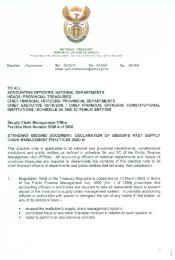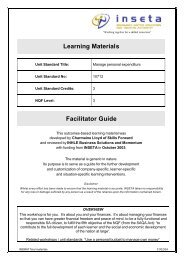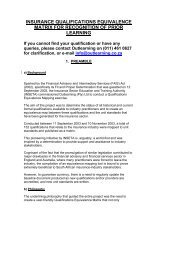SSP Brochure:Layout 1 - INSETA
SSP Brochure:Layout 1 - INSETA
SSP Brochure:Layout 1 - INSETA
Create successful ePaper yourself
Turn your PDF publications into a flip-book with our unique Google optimized e-Paper software.
• increasing reinsurance rates;• increasing competition between brokers and direct distribution channels;• legislation that is causing higher direct compliance costs.Figure 1-8 Trends in premium incomes and benefits paid by short-term insurers: years ended 31 December 1999-2006** 2000 values calculated by using the CPI.Sources: Financial Services Board, Special report on the results of the long-term insurance Industry for the periods ended December 2004, (15 February 2005), December2005 (15 February 2006) December 2006 (15 February 2007).ReinsuranceReinsurers are generally international companies that tend to consider reinsurance issues globally. The reinsurance industry grew priorto 2003 and stabilised between 2003 and 2004. Growth before 2003 can be ascribed to growth in the insurance industry. Since 2003,the insurance companies have reassessed the manner in which they employ capital. A move is discernible towards greater capitalretention rather than passing capital on to reinsurers. The companies have moved from proportional reinsurance to non-proportionalreinsurance to retain more premium and to absorb more of the initial risks and losses themselves. Further growth in the reinsurancesector is expected in the life subsector, but the non-life subsector will probably remain static. The size of the portfolios will likelyincrease in the life subsector, but this will not necessarily mean that more employees will be needed. The larger portfolios will bemanaged with current staff numbers and greater use of technology. 30Collective investmentsThe collective investments subsector is a high-growth area in the insurance industry. The number of investment schemes in securitiesincreased from 156 in 1998 to 718 in 2006, and the assets under management increased from R78 billion in 1998 to R459 billion in2006 (Figure 1.9). Growth in investment schemes in property was equally impressive (Figure 1.10). The total market capitalisationof these funds increased from R 4.2 billion in 2000 to R 17.0 billion in 2006.30 Opinion expressed by SAROA in a personal interview.<strong>INSETA</strong> Sector Skills Plan - page 10
















